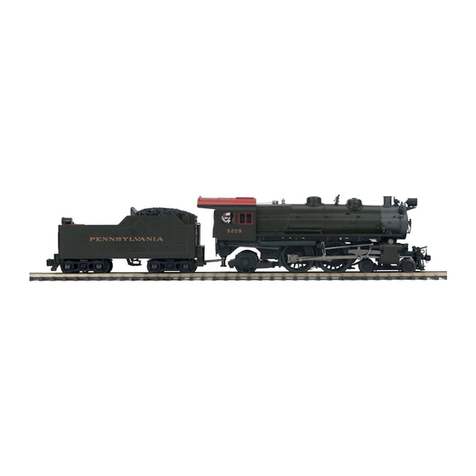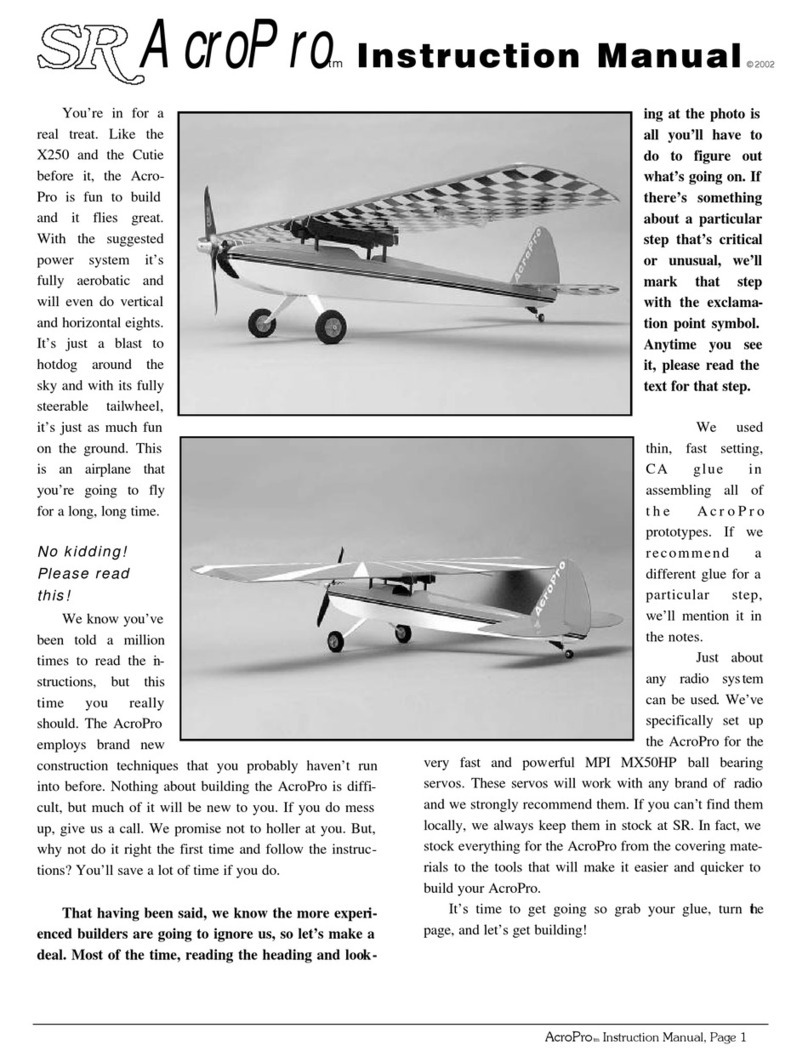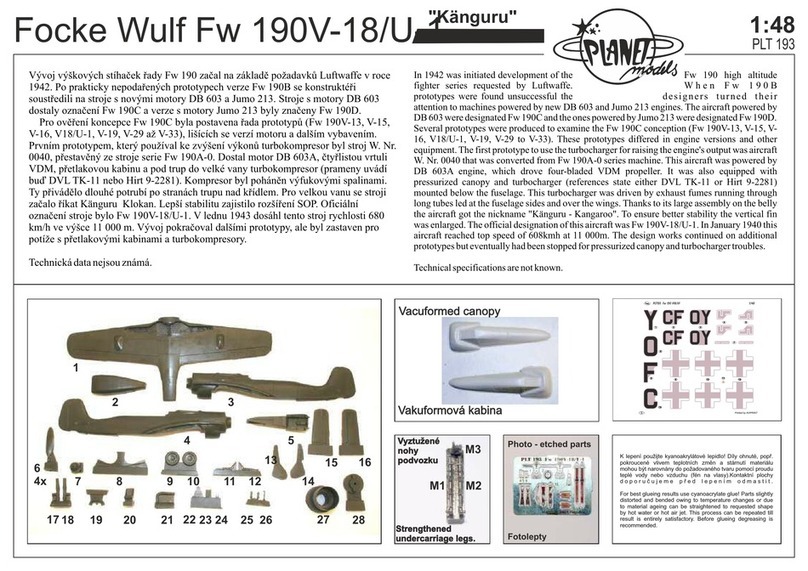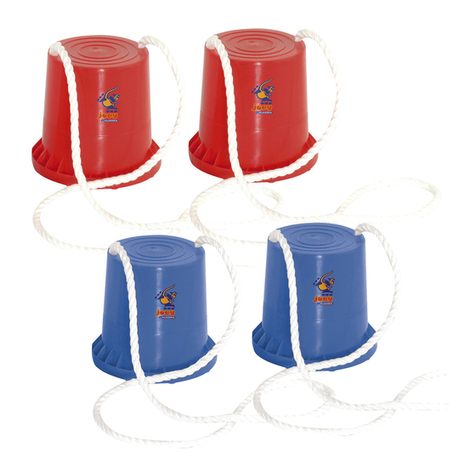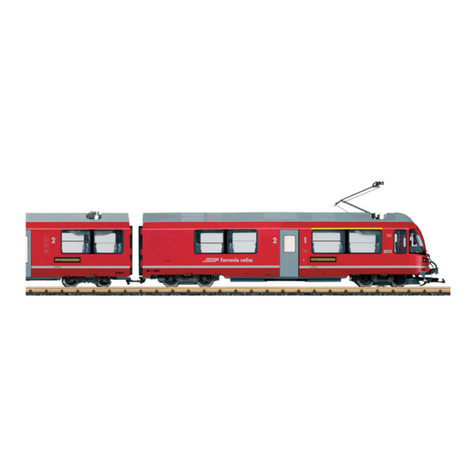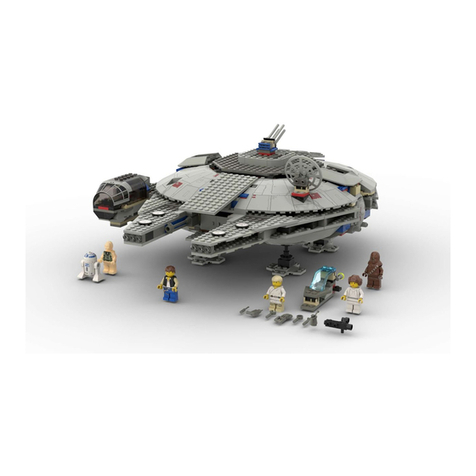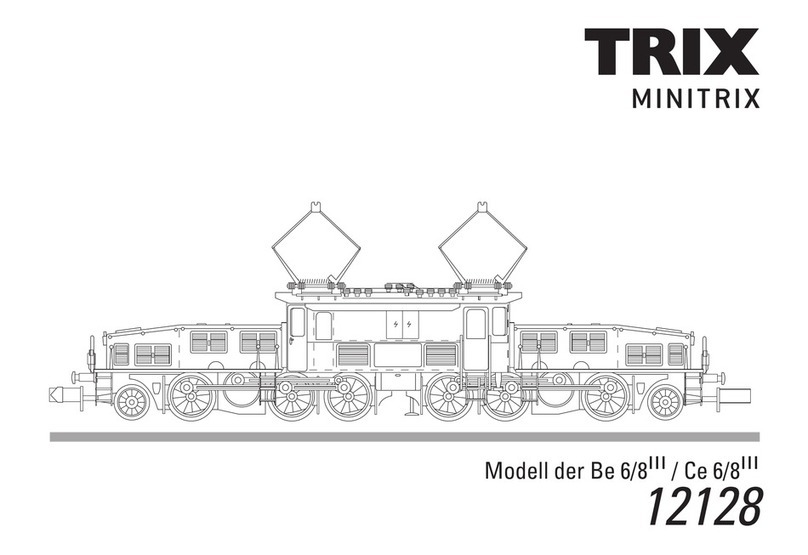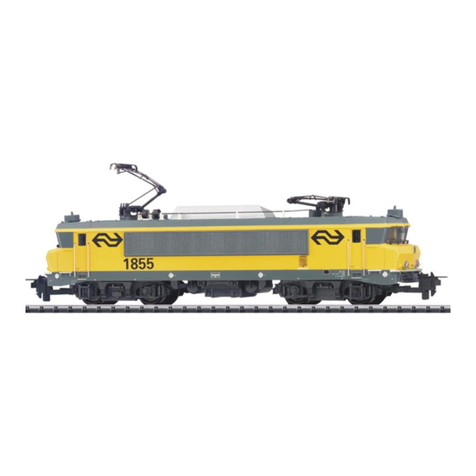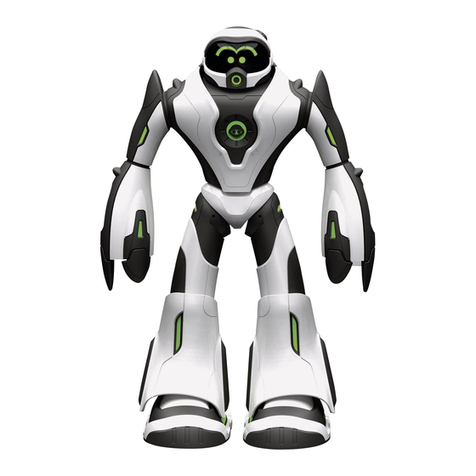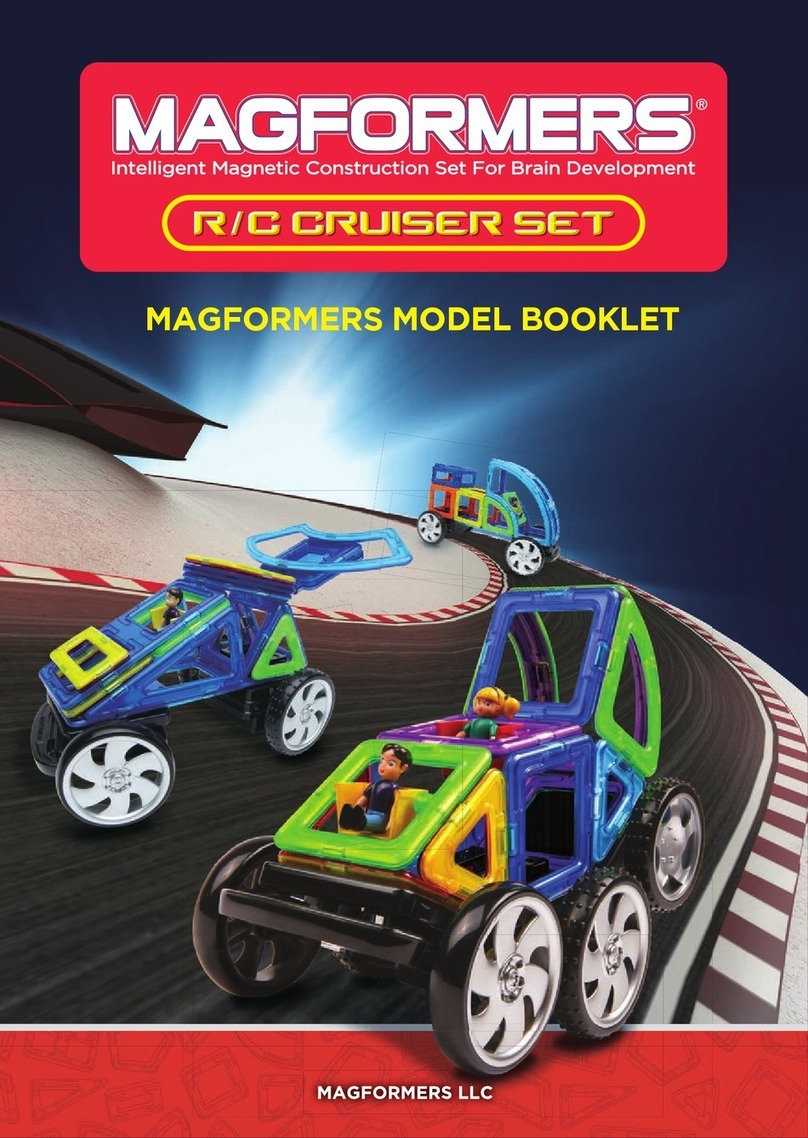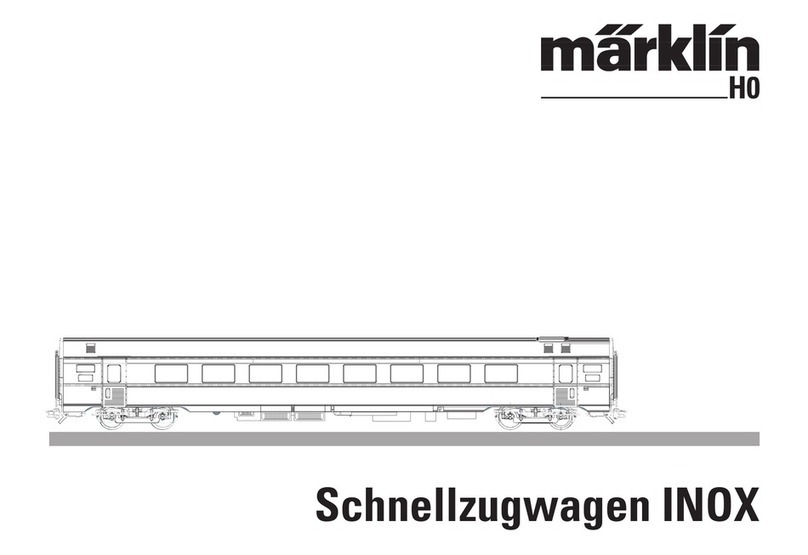Top Gun F/A-18C Hornet User manual


2
Hornet F/A18C
Model
INSTRUCTION MANUAL
Top Gun Park Flite are proud to present this high
performance ducted fan sport scale model of the F/A
18 Hornet. This model is designed for intermediate to
advanced model flyers and emulates the style,
performance and character of its full size jet powered
counterpart. Due to its high performance and large
turning circle it is not a beginners’ model and should
only be flown on recognised club sites.
Supplied as an Almost Ready to Fly package with a
powerful brushless motor coupled to a ducted fan,
electronic speed control and all servos installed, the
F/A 18 Hornet requires minimal assembly before
installing the supplied LiPo flight battery and
commencing flying.
This model has been designed with the utmost care
and attention to detail to produce a light weight,
strong, and realistic looking model aeroplane with
excellent flying characteristics.
We feel that this model emulates the style,
performance and character of its full size counterpart.
This model is a high performance miniature aircraft
that allows intermediate to advanced model pilots to
perform both scale and aerobatic manoeuvers. The
light weight, large wing area and powerful ducted fan
motor assembly allow the model to fly both fast and
slow, with high speed rolls and tight turns while
maintaining full control.
These instructions assume a reasonable level of
competence for both building and flying and we
recommend that the model is flown at a recognised
club with frequency control measures and suitable
third party insurance.
The owner – pilot of this model should take note of
regulations, and local bylaws before flying this aircraft.
Please take time to read through these instructions
before commencing assembly. We list operations in
order of works to reduce the risk of damage during
assembly.
Please read through the warnings before use.
A 14.8V lithium polymer (LiPo) battery is included as
part of this package and these cells must be operated
with care to prevent the risk of fire.
LiPo Batteries are soft cased and can be easily
damaged by sharp items, puncturing of the soft casing
can cause fires and we recommend that they are
stored and handled carefully.
Use only a LiPo rated charger, set to a maximum of 4
cells (14.8v) and no more than 2 amp charge current.
Remove battery from the aircraft and charge on a non
flammable, non conductive surface
Due to continual and ongoing product development the
parts shown in the manual may differ from those
supplied.
Congratulations on purchasing the Hornet F/A18C RTF

3
SECTION 1: KIT CONTENTS AND DESCRIPTION
SPECIFICATIONS
Wing span 780mm (30.71”)
Length 1160mm (51.65”)
Wing Area 12.5 Dm_ (194 sq inches)
Weight 850 g (30 Ounces)
Radio 4 Qty micro servos
45 Amp brushless ESC
Motor Brushless motor
5 blade ducted fan
14.8v 2200mAh LiPo battery
1. Fuselage with ducted fan, motor, Electronic
Speed Control (ESC), 4 Lipo BEC unit, elevator
servos and steering servo.
2. Fuselage nosecone section
3. Two wing panels with factory hinged ailerons
with control horns connected to factory installed
servos
4. Two horizontal stabiliser panels with factory
hinged elevators
5. Two vertical stabiliser-fin panels
6. Main and nose undercarriage assemblies with
wheels and mounting hardware
7. Elevator pushrods, control horns, linkage and
fixing hardware
8. Tube of adhesive
9. LiPo Battery 4 cell 11.1V 1300 mAh (15c)
10. Self adhesive decals.

4
MAIN FUSELAGE ASSEMBLY.
Supplied complete with ducted fan unit using high
performance brushless in runner motor.
45Amp Electronic Speed Control (ESC) pre-wired to
motor with extended leads to forward battery box
and hinged cover.
Nose cone supplied loose, for fixing to forward
fuselage.
WING PANELS.
Supplied as two halves.
Each wing half includes factory hinged aileron with
control horn installed.
Fzactory fitted aileron servos in each wing with
pushrod connected between servo arm and control
horn.
Two horizontal stabiliser panels with factory hinged
elevators
Note Elevators are pre drilled to receive control
horns.
Two vertical stabiliser-fin panels.
Supplied as handed pair.
Lower section mates to fuselage upper corner.

5
Undercarriage assemblies.
Two sets of lightweight wheels fixed onto wire
torque rod undercarriage.
Four clamp plates and 8 fixing screws for securing
to fuselage plates.
Coil spring nose gear assembly.
Elevator pushrods, control horns, and fixing
hardware.
Two long pushrods with clevis connector.
Two Control horns with back plates and fixing
screws.
BATTERY
14.8V (4 cell) 2200mAh (C) LiPo Battery rated at
15C max discharge.
Fitted with 3.5mm gold plug and socket power
connections and balance lead.
ADHESIVE
5ml tube of foam safe adhesive.
Note pierce end of tube with pin in screw on lid.
DECALS
Water slide decals for final decoration of model.
THE FOLLOWING ITEMS ARE REQUIRED TO
COMPLETE AND FLY THIS MODEL
• Transmitter with 4 or more functions.
• Minimum 4 function full range receiver compatible
with transmitter.
• LiPo rated charger, set to a maximum of 4 cells
(14.8v) and no more than 2 amp charge current.

6
SECTION 2: BATTERY AND CHARGING
SECTION 3: ASSEMBLY
Locate the main undercarriage assemblies, clamp
plates and fixing screws.
Insert undercarriage into mounting plate located in
fuselage side and fix in place with saddles and four
self tapping screws.
Note wheel is located towards the front of the
fuselage.
Locate the nose wheel and coil assembly.
This slides into the collet located beneath the
cockpit.
Align the flat in the wire with the grub screw.
The coil will face forward and tighten with 1.5mm
allen key.
Locate the plastic nose cone and apply a bead of
adhesive to its inside edge.
Push onto the fuselage, wipe off excess adhesive
and allow to dry.
Locate the two horizontal stabiliser panels, control
horns and fixings.
WARNING:
A lithium polymer (LiPo) battery rated at 15C
(33A) is included as part of this package, these
cells must be operated with care to prevent the
risk of fire.
LiPo Batteries are soft cased and can be easily
damaged by sharp items, puncturing of the soft
casing can cause fires and we recommend that
they are stored and handled carefully.
Use only a LiPo rated charger set to a maximum
of 4 cells (14.8v) and less than 2 amp (2000mAh)
charge current.
Remove battery from the aircraft and charge on a
non flammable, non conductive surface
Charger pictured for reference,
but not included

7
Position the control horn over the recess moulded in
the elevator and fix in place with two screws and
backplate.
Ensure that you have a handed pair before fixing to
the fuselage.
Test fit the two horizontal stabiliser panels onto rear
of fuselage with control horns on underside.
Apply adhesive to the recess in the fuselage contact
faces and press firmly together and use pins or tape
to hold in place.
Wipe off any excess adhesive and allow to dry.
Locate the long elevator pushrods and slide the Z-
bend through the middle hole in the servo arm.
Push the clevis connector into the hole in the horn
furthest from the elevator surface.
Click the clevis connector closed.
Repeat the procedure to both elevators.
Locate the wing halves and fuselage assembly and
dry fit the wings and fuselage together.
Apply adhesive on one wing panel and the mating
area on the fuselage. Press into position and use
tape or bands to hold in place.
Wipe off any excess adhesive and allow to dry.
Repeat the procedure to the other wing.
Connect the aileron servo leads to the extensions
located in the fuselage matching black to black and
white to white (orange).
Tuck wires into slot and apply self adhesive tape
over slot.

8
Repeat on opposite wing panel.
SECTION 3: ASSEMBLY CONTINUED
Locate the two vertical stabiliser-Fin panels and test
fit onto rear of fuselage noting that they slope
outwards.
Apply adhesive to the contact faces and press firmly
together and use pins or tape to hold in place.
Wipe off any excess adhesive and allow to dry.
Apply the water slide decals using the pictures on
the box and within the instructions for guidance.
The decals are based on the 2006 year display team
comprising the following officers;
No 1 Cdr Steve Foley
No 2 Lt Anthony Walley
No 3 Lt Tom Winkler
No 4 Maj Matt Shortal
No 5 Lcdr Ted Steelman,
No 6 Lcdr John Allisopn
The construction phase is now complete and the
following steps are final radio installation and set
up.

9
SECTION 4: FINAL SET UP
Open the radio hatch fixing and ease connection
plugs out.
The hatch is located in the forward fuselage just
behind the nose gear.
Fully un-coil the receiver aerial and route to the top
of the fin using adhesive tape to hold in position.
Connect the receiver to the servo leads in the radio
bay. The servo leads are marked up for Futaba and
compatible radios. Insert receiver in the radio bay,
Y leads are used to remove the need for mixing
functions.
Channel No 1 Ailerons – Left and Right
Channel No 2 Elevator– Left and Right
Channel No 3 Electronic speed Control (throttle)
Channel No 4 Nose wheel steering
Open the hinged battery bay door by turning the
catches.
Insert the battery and ensure that battery and ESC
leads project out of the aperture.
Ensure that transmitter is switched on with throttle
down.
Connect the battery and ESC leads together Red-
Red and Black-Black and close the battery cover
using the catches to lock it in place.
CHECK THE BALANCE.
The model should sit level or slightly nose down
when supported upside down from a point 85mm –
90mm back from the point where the wing leading
edge joins the fuselage. This corresponds to a point
midway along the top surface air brakes panel line.
DO NOT ATTEMPT TO FLY WITH A REARWARD
BALANCE POINT
WARNING:
With the battery connected and the model
switched on the motor is now live. The
Electronic speed controller (ESC) will go through
its start up procedure and will emit a series of
beeps while it configures throttle positions. The
motor could start unexpectedly and we
recommend that the model is restrained during
handling.
CENTRE OF GRAVITY POINT

10
SECTION 5: FIRST FLIGHT
BEFORE THE TEST FLIGHT
On completion of the model take time to test the
model in the workshop.
Switch on the transmitter; connect the battery and
double check that all surfaces operate in the correct
manner without stalled servos.
Check for adequate range with and without motor
running.
If everything is okay, take it to the flying field and
rig it up again.
Always follow the frequency control procedures of
your local flying site and ensure that you have
adequate third party insurance cover.
Repeat the full pre flight inspection before flying.
FLYING
The F/A 18 Hornet is capable of 5 to 10 minute flight
times and can R.O.G (Rise Off Ground) from smooth
metalled or very short cut and smooth grass
runways. A hand launch will be required If flying
without undercarriage.
The F/A 18 Hornet displays scale like flying
characteristics and the take off run should be as
long as possible, accelerate to maximum
groundspeed before applying up elevator to take off
and then climb out at a shallow angle.
Climb to a safe height to explore the models
performance, it is aerobatic and able to perform
loops and rolls.
Due to its light weight it should not be flown in wind
greater than 10mph.
Control throws set during assembly will produce a
model capable of flying smooth scale like
performance and medium to high speed aerobatic
manoeuvers.
The control surface movements can be increased by
moving the clevis connectors nearer to the control
surfaces.
To reduce movements move the pushrod
connections nearer to the servo on the output arms
and further out along the control surfaces horns.
WARNING:
Do not advance the throttle unless the model is
restrained. With the powerful motor - fan
combination, the model will accelerate across a
smooth surface very quickly.
ENJOY YOURSELF BUT ALWAYS FLY SAFE!

11
IMPORTANT SAFETY INSTRUCTIONS AND WARNINGS – READ BEFORE USE
• Lithium Polymer batteries can be volatile. Whilst some of the instances listed below are rare, they can occur and it is
important for you to be aware of how to handle such situations. Failure to read and follow the below instructions may
result in fire, personal injury and damage to property if charged or used improperly.
• Top Gun Park Flite, its distributors or retailers assume no liability for failures to comply with these warnings and safety
guidelines.
• By using this battery, the buyer assumes all risks associated with lithium batteries. If you do not agree with these
conditions, return the battery immediately before use.
• The final use and preparation of the battery pack is ultimately beyond our control and those of our representatives and
retaillers. Your decision to use this product incorporates your agreement that you have read and understood the safety
precautions listed below and on each battery pack, and that you agree to accept full responsibility for any injury, loss or
damage resulting from all circumstances surrounding your use or misuse of this product.
GENERAL GUIDELINES AND WARNINGS
1) Only use the supplied specific Lithium Polymer charger. Do not use a NiMH or NiCd charger - Failure to do so may a cause fire, which
may result in personal injury and property damage.
2) Never charge batteries unattended. When charging LiPo batteries you should always remain in constant observation to monitor the
charging process and react to potential problems that may occur.
4) If at any time you witness a battery starting to balloon or swell up, discontinue charging process immediately, disconnect the battery
and observe it in a safe place for approximately 15 minutes. This may cause the battery to leak, and the reaction with air may cause the
chemicals to ignite, resulting in fire.
5) Since delayed chemical reaction can occur, it is best to observe the battery as a safety precaution. Battery observation should occur in a
safe area outside of any building or vehicle and away from any combustible material.
6) Wire lead shorts can cause fire! If you accidentally short the wires, the battery must be placed in a safe area for observation for
approximately 15 minutes. Additionally, if a short occurs and contact is made with metal (such as rings on your hand), severe injuries
may occur due to the conductibility of electric current.
7) A battery can still ignite even after 10 minutes.
8) In the event of a crash, you must remove battery for observation and place in a safe open area away from any combustible material for
approximately 15 minutes.
11) Never store or charge battery pack inside your car in extreme temperatures, since extreme temperature could ignite fire.
CHARGING PROCESS
1) Never charge batteries unattended.
2) Charge in an isolated area, away from any flammable materials and inside a closed tin or lipo charge sack. In the unlikely event that the
battery may fail and ignite, this procedure will ensure that a possible battery fire is contained and limiting any possible damage.
3) Let battery cool down to ambient temperature before charging.
DISCHARGE
Ensure that you adhere to the warning beeps on your transmitter and land the model accordingly. Do not fly until the battery is completely
discharged as damage will occur.
STORAGE & TRANSPORTATION
1) Store battery at room temperature between 40 and 80 degrees F for best results.
2) Do not expose battery pack to direct sunlight (heat) for extended periods.
3) When transporting or temporarily storing in a vehicle, temperature range should be greater than 20 degrees F but no more than 150
degrees F.
4) Storing battery at temperatures greater than 170 degrees F for extended periods of time (more than 2 hours) may cause damage to
battery and possible fire.
BATTERY LIFE
Batteries that lose 20% of their capacity must be removed from service and disposed of properly. Discharge the battery to 3V/Cell, making sure
output wires are insulated, then wrap battery in a bag for disposal.
PRODUCT WARRANTY
Product warranty is limited to original defects in material and workmanship. Warranty does not cover collateral damage. Due to the nature and
use of the battery there is no term warranty. Misuse, abuse, incorrect charging and other inappropriate use of this product are not covered
under warranty.

12
ADDENDUM
REMOVAL OF UNDERCARRIAGE
For an improved in flight performance and
appearance the tricycle undercarriage can be
removed.
Removal of the undercarriage assemblies reduces
both the weight and drag of the model increasing
the power to weight ratio and top speed, the wing
loading also drops slightly which improves
manoeuvrability.
The decision should not be taken lightly though.
Without an undercarriage the model must be hand
launched firmly into wind and belly landings will be
the norm.
While the aircraft can be built without undercarriage
, we recommend that the model is assembled and
flown with wheels initially to allow time to
familiarise with the aircrafts performance.
While the main wheels and nose gear can easily be
removed and replaced, removal of the nose wheel
steering servo requires ‘minor surgery’.
Removal of the main gears is a simple task involving
removal of the fixing screws, clamp plates and
formed undercarriage assemblies. Similarly the
nose wheel is removed by removing the grubscrew
and pulling the wire out of the collet.
To remove the steering servo slide a thin modelling
blade between the canopy and fuselage to break the
glue joints and remove the canopy
Disconnect the nose gear steering servo from the
receiver.
Disconnect the steering push rod and slide a thin
modelling blade between the servo and fuselage to
break the glue joints. Remove the servo
Refit the canopy with a few drops of adhesive.
With the main wheels removed the wheel wells form
an ideal finger and thumb hold for hand launching.

13
TGP0220B F/A-18C BLUE ANGELS RTF 70mm EDF
TGP0220S F/A-18C SILVER RTF 70mm EDF
TGP0221B F/A-18C BLUE ANGELS ARTF 70mm EDF
TGP0221S F/A-18C SILVER ARTF 70mm EDF
TGP0222B F/A-18C BLUE ANGELS AIRFRAME 70mm
EDF JET
TGP0222S F/A-18C SILVER AIRFRAME 70mm EDF
TGP0225B F/A18-C FUSELAGE (BLUE)
TGP0225S F/A18-C FUSELAGE (SILVER)
TGP0226B F/A18-C MAIN WING SET (BLUE)
TGP0226S F/A18-C MAIN WING SET (SILVER)
TGP0227B F/A18-C VERTICAL TAIL SET BLUE
TGP0227S F/A18-C VERTICAL TAIL SET SILV
TGP0228B F/A18-C HORIZONTAL TAIL BLUE
TGP0228S F/A18-C HORIZONTAL TAIL SILVER
TGP0229B F/A18-C PVC PARTS SET BLUE
TGP0229S F/A18-C PVC PARTS SET SILVER
TGP0230 F/A18-C LANDING GEAR
TGP0231 F/A18-C CONTROL RODS & PLASTIC
TGP0112 F/A-18C 70mm DUCTED FAN UNIT
TGP0524 F/A-18C 2200mah 14.8V 15C LIPO
TGP0533 F/A-18C INRUNNER MOTOR
TGP0553 F/A-18C 45A BRUSHLESS ESC
TGE0001 ETRONIX 8.4G MINI SERVO
DISTRIBUTORS OF QUALITY MODEL & HOBBY PRODUCTS
Saxon House, Saxon Business Park, Hanbury Road, Bromsgrove, Worcestershire. B60 4AD. England
Tel: +44 (0) 1527 575349 Fax: + 44 (0) 1527 570536
E-mail: [email protected]
Web site: www.cmldistribution.co.uk
TOP GUN HORNET F18C SPARE PARTS LIST
Table of contents
